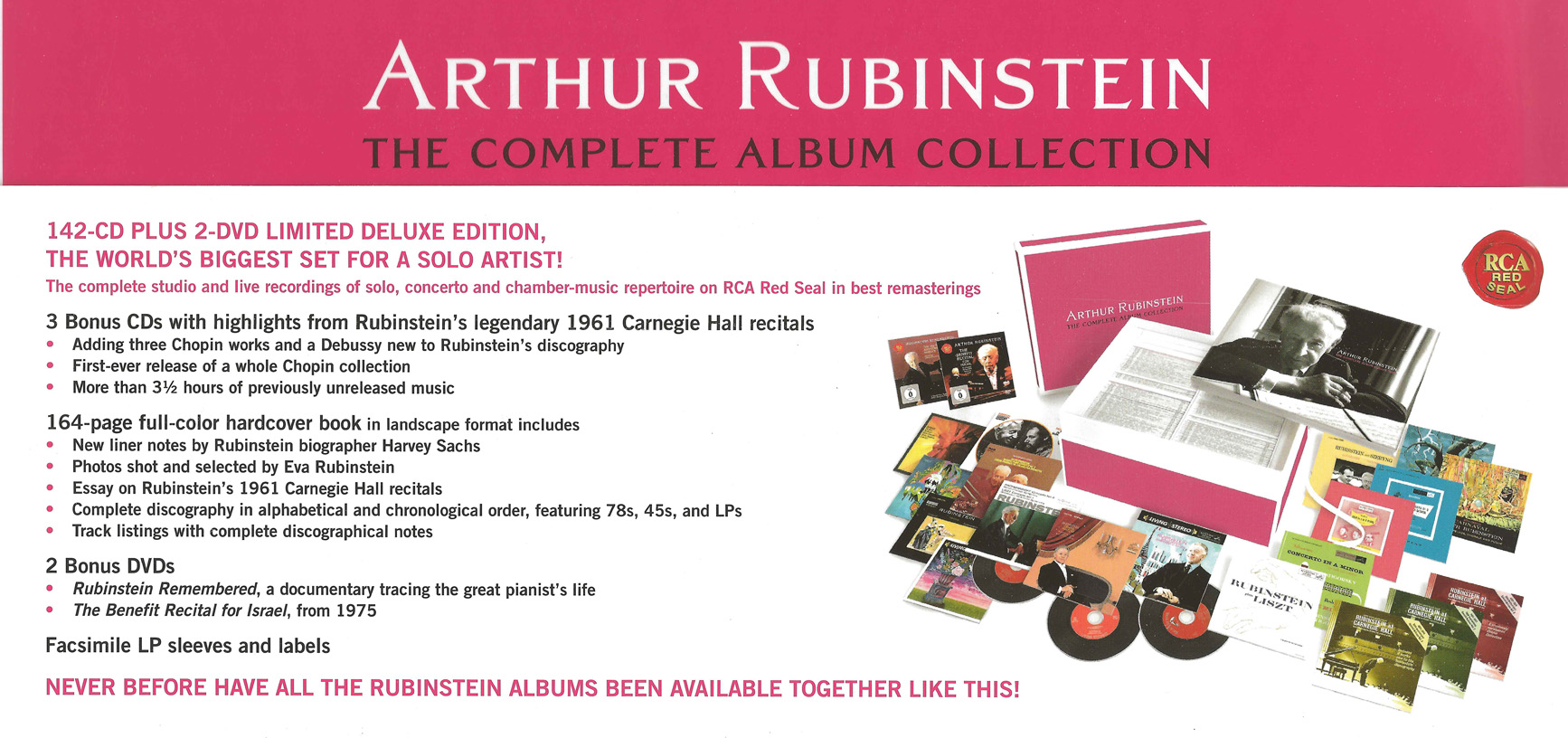Piano Music by César Franck
Arthur Rubinstein
Media Review / Listening Diary 2014-12-29
2014-12-29 — Original posting
2016-07-31 — Brushed up for better readability
Table of Contents
Rubinstein’s Recorded “French” Solo Repertoire:
Piano Music by César Franck (1822 – 1890)
Arthur Rubinstein‘s solo repertoire (as included in “Arthur Rubinstein —The Complete Album Collection“, i.e., recorded though his exclusive contract with RCA/Victor) features a single composition by César Franck: the Prélude, Choral et Fugue, a late work, composed in 1884. In the above title, I put “French” in quotes: César Franck has indeed spent most of his life in Paris, but he was born in Liège (then part of The Netherlands, now in Belgium).
The CDs
Here are the CDs for Arthur Rubinstein’s recordings of that composition by Franck:
Arthur Rubinstein Collection, CDs #11 – 14
Arthur Rubinstein — The Complete Album Collection
CDs #11 – 14: The Early Recordings 1938 – 1949
SONY Classical 88691936912 (142 CDs / 2 DVDs, mono / stereo); ℗ / © 2011
Documentation 162 pp., track listing on CD sleeve

Arthur Rubinstein Collection, CD #49
Arthur Rubinstein — The Complete Album Collection
CD #49: Schumann: Carnaval, op.9; Franck: Prélude, Choral & Fugue
SONY Classical 88691936912 (142 CDs / 2 DVDs, mono / stereo); ℗ / © 2011
Documentation 162 pp., track listing on CD sleeve

Arthur Rubinstein Collection, CD #130
Arthur Rubinstein — The Complete Album Collection
CD #130: Franck: Prélude, Choral & Fugue; Bach-Busoni: Chaconne; Mozart: Rondo K.511
SONY Classical 88691936912 (142 CDs / 2 DVDs, mono / stereo); ℗ / © 2011
Documentation 162 pp., LP liner notes on backside of CD sleeve

Prélude, choral et fugue (1884)
This is a three-part composition with a duration of 17 – 19 minutes, which Rubinstein has recorded three times over his career: 1945, 1952, and 1970. Wikipedia lists it as op.21 — but that opus number is taken by the Final in B♭ major…
- Prélude: Moderato (4/4 — 2/4 — 4/4 — 2/4 — 4/4)
This is a free-form Prelude in 4/4, interrupted by two single 2/4 bars, each annotated a capriccio, which don’t really split the piece — superficially, it merely sounds “less rhythmic” in these places. The basic “theme” consists of wide-ranging broken chords, interwoven with a single, marked melody line, a virtuosic, full-sounding piece - Choral: Poco più lento (4/4, molto cantabile, non troppo dolce) — Poco Allegro
Here, the left hand plays in octaves, the right hand plays the chorale melody over wide-spanning chords. The verses of the chorale are separated by broad arpeggiando sections, at a walking pace. The movement concludes with a short Poco Allegro section that leads into a dramatic accelerando, then into a transition to the Fugue. - Fugue: Tempo I — Vivo
The fugue is in four parts, also using the inversion of the main theme. The piece is compounded by a return of the Prélude (including one a capriccio bar), into which the fugue is resumed. This is followed by a cadenza (Come una cadenza), then also the Chorale returns, and finally all elements are combined. This leads into a final Vivo climax / apotheosis. It’s a grandiose conclusion of the composition, with wide-ranging chords, full sound and jubilant harmonies. The piece often inspired by the sound / sonority and the language of an organ — yet so brilliantly pianistic
Rubinstein’s Interpretations
The three movements are played attacca. There are a few, brief resting points, such as a fermata preceding the Poco Allegro, the implicit / composed fermatas prior to the a capriccio bars (though theoretically there is no rest in these bars, as Franck specifically asks for the sustain pedal to be kept down; Rubinstein leaves a short rest anyway), and the fermata preceding the cadenza in the Fugue. Arthur Rubinstein’s three interpretations aren’t all that different — they can be briefly characterized as follows:
1945 (mono)
Durations: Prélude 4’38” — Choral 6’04” — Fugue 6’15” (total: 16’57”)
Virtuosic — there is less focus on the ultimate detail and transparency. One instantly recognizes the faster pace in the outer movements. There are obviously limitations in the sound: the piano sound is OK per se, but the recording sounds a bit like heard through a small window.
1952 (mono)
Durations: Prélude 4’59” — Choral 6’17” — Fugue 6’44” (total: 17’59”)
Clarity, transparency, full sound, more consistent in the tempo — very impressive! I think, technically this is the best performance by the artist, and even the sound — though mono, still — is impressive (I wonder whether Rubinstein would have bothered re-doing the recording in stereo, had he heard how good modern restoration techniques work!). If you are looking for the hair in the soup: occasionally, the piano sounds a bit hard, maybe — but then, with Frank’s piano texture, occasional twanging of strings is practically unavoidable.
1970 (stereo)
Durations: Prélude 5’03” — Choral 6’48” — Fugue 6’54” (total: 18’44”)
Clarity and contemplation: the biggest change here is in the Chorale, where the arpeggiando sections are broader, less forced. It’s amazing to se how little one recognizes the 18 years time difference between this and the preceding interpretation. Rubinstein was 83 when he made this last recording. One has to listen very carefully to find signs of the artist’s age (well-hidden, minor things, really, and the recording overall is a bit less energetic than the earlier ones). Of course, the sound here is stereo. So, if one is listening with head- or earphones, it feels like sitting almost in the concert grand.
Conclusion
Clearly, sound-wise (as a recording), the last recording has the edge. However, artistically, I prefer the 1952 recording.
Listening Diary Posts, Overview







